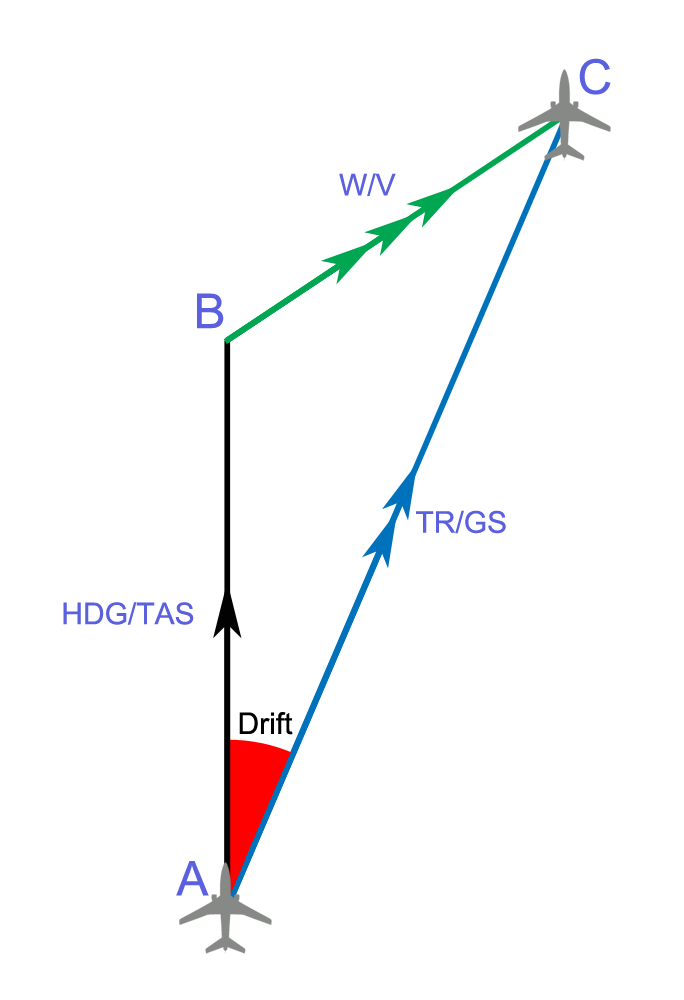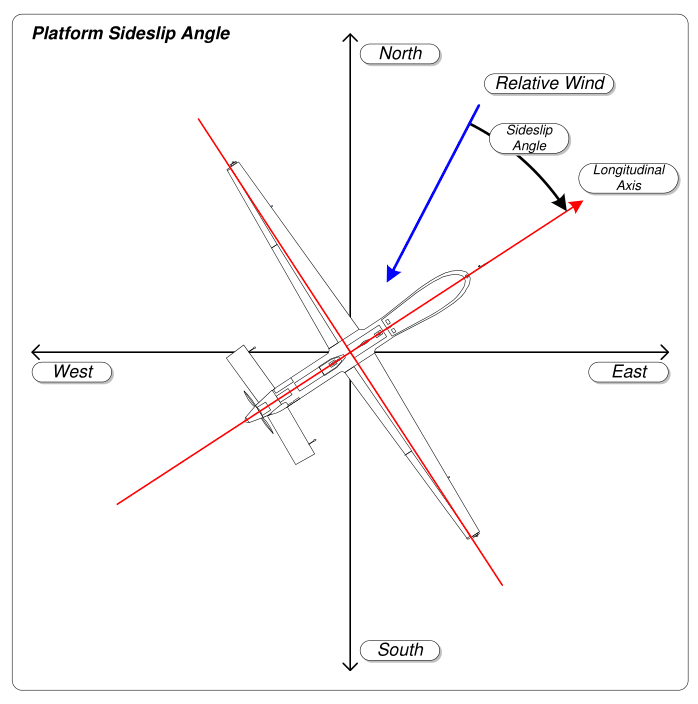|
Drift (navigation)
In navigation, the drift of a vessel or aircraft is the difference between heading and its course or track, due to the motion of the underlying medium, the air or water, or other effects like skidding or slipping. it can be determined by the wind triangle In air navigation, the wind triangle is a graphical representation of the relationship between aircraft motion and wind. It is used extensively in dead reckoning navigation. The wind triangle is a vector diagram, with three vectors. *The air ve .... References Navigation {{water-transport-stub ... [...More Info...] [...Related Items...] OR: [Wikipedia] [Google] [Baidu] |
Wind Drift
Wind is the natural movement of air or other gases relative to a planet's surface. Winds occur on a range of scales, from thunderstorm flows lasting tens of minutes, to local breezes generated by heating of land surfaces and lasting a few hours, to global winds resulting from the difference in absorption of solar energy between the climate zones on Earth. The two main causes of large-scale atmospheric circulation are the differential heating between the equator and the poles, and the rotation of the planet (Coriolis effect). Within the tropics and subtropics, thermal low circulations over terrain and high plateaus can drive monsoon circulations. In coastal areas the sea breeze/land breeze cycle can define local winds; in areas that have variable terrain, mountain and valley breezes can prevail. Winds are commonly classified by their spatial scale, their speed and direction, the forces that cause them, the regions in which they occur, and their effect. Winds have various as ... [...More Info...] [...Related Items...] OR: [Wikipedia] [Google] [Baidu] |
Navigation
Navigation is a field of study that focuses on the process of monitoring and controlling the movement of a craft or vehicle from one place to another.Bowditch, 2003:799. The field of navigation includes four general categories: land navigation, marine navigation, aeronautic navigation, and space navigation. It is also the term of art used for the specialized knowledge used by navigators to perform navigation tasks. All navigational techniques involve locating the navigator's position compared to known locations or patterns. Navigation, in a broader sense, can refer to any skill or study that involves the determination of position and direction. In this sense, navigation includes orienteering and pedestrian navigation. History In the European medieval period, navigation was considered part of the set of '' seven mechanical arts'', none of which were used for long voyages across open ocean. Polynesian navigation is probably the earliest form of open-ocean navigation; it was ... [...More Info...] [...Related Items...] OR: [Wikipedia] [Google] [Baidu] |
Heading (navigation)
In navigation, the heading of a vessel or aircraft is the compass direction in which the craft's bow or nose is pointed. Note that the heading may not necessarily be the direction that the vehicle actually travels, which is known as its '' course'' or ''track''. Any difference between the heading and course is due to the motion of the underlying medium, the air or water, or other effects like skidding or slipping. The difference is known as the ''drift'', and can be determined by the ''wind triangle''. At least seven ways to measure the heading of a vehicle have been described. Notation Heading is typically based on cardinal directions, so 0° (or 360°) indicates a direction toward true north, 90° true east, 180° true south, and 270° true west. TVMDC TVMDC is a mnemonic for converting true, magnetic and compass headings. TVMDC is a mnemonic initialism for true heading, variation, magnetic heading, deviation, compass heading. The most common use of the TVMDC method is co ... [...More Info...] [...Related Items...] OR: [Wikipedia] [Google] [Baidu] |
Course (navigation)
In navigation, the course of a watercraft or aircraft is the cardinal direction in which the craft is to be steered. The course is to be distinguished from the ''heading'', which is the direction where the watercraft's bow or the aircraft's nose is pointed. Course, track, route and heading The path that a vessel follows over the ground is called a ''ground track'', ''course made good'' or ''course over the ground''. For an aircraft it is simply its ''track''. The intended track is a ''route''. For ships and aircraft, routes are typically straight-line segments between waypoints. A navigator determines the ''bearing'' (the compass direction from the craft's current position) of the next waypoint. Because water currents or wind can cause a craft to drift off course, a navigator sets a ''course to steer'' that compensates for drift. The helmsman or pilot points the craft on a ''heading'' that corresponds to the course to steer. If the predicted drift is correct, then the ... [...More Info...] [...Related Items...] OR: [Wikipedia] [Google] [Baidu] |
Skid (aerodynamic)
In a straight flight, the tail of the airplane aligns the fuselage into the relative wind. However, in the beginning of a turn, when the ailerons are being applied in order to bank the airplane, the ailerons also cause an adverse yaw of the airplane. For example, if the airplane is rolling clockwise (from the pilot point of view), the airplane yaws to the left. It assumes a crab-like attitude relative to the wind. This is called a slip. The air is flowing crosswise over the fuselage. In order to correct this adverse slip, the pilot must apply rudder (right rudder in this example). If the pilot applies too much rudder, the airplane will then slip to the other side. This is called a skid. Stall The skid is more dangerous than the slip if the airplane is close to a stall. In the slip, the raised wing — the left one if the airplane is turning to the right — will stall before the lowered one, and the airplane will reduce the bank angle, which prevents the stall. In the skid ... [...More Info...] [...Related Items...] OR: [Wikipedia] [Google] [Baidu] |
Slip (aerodynamic)
A slip is an aerodynamic state where an aircraft is moving ''somewhat'' sideways as well as forward relative to the oncoming airflow or relative wind. In other words, for a conventional aircraft, the nose will be pointing in the opposite direction to the bank of the wing(s). The aircraft is not in coordinated flight and therefore is flying inefficiently. Background Flying in a slip is aerodynamically inefficient, since the lift-to-drag ratio is reduced. More drag is at play consuming energy but not producing lift. Inexperienced or inattentive pilots will often enter slips unintentionally during turns by failing to coordinate the aircraft with the rudder. Airplanes can readily enter into a slip climbing out from take-off on a windy day. If left unchecked, climb performance will suffer. This is especially dangerous if there are nearby obstructions under the climb path and the aircraft is underpowered or heavily loaded. A slip can also be a ''piloting maneuver'' where the pilot del ... [...More Info...] [...Related Items...] OR: [Wikipedia] [Google] [Baidu] |
Wind Triangle
In air navigation, the wind triangle is a graphical representation of the relationship between aircraft motion and wind. It is used extensively in dead reckoning navigation. The wind triangle is a vector diagram, with three vectors. *The air vector represents the motion of the aircraft through the airmass. It is described by true airspeed and true heading. *The wind vector represents the motion of the airmass over the ground. It is described by wind speed and the inverse of wind direction. Note that by convention wind direction is given as the direction the wind is ''from''. In a vector diagram such as the wind triangle, wind direction must be stated as the direction the wind is blowing ''to'', or 180 degrees different from the convention. *The ground vector represents the motion of the aircraft over the ground. It is described by ground track and ground speed. The ground vector is the resultant of algebraically adding the air vector and the wind vector. The wind triangle ... [...More Info...] [...Related Items...] OR: [Wikipedia] [Google] [Baidu] |



